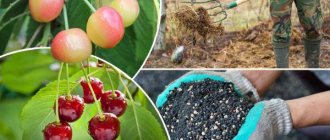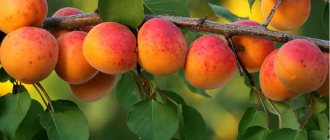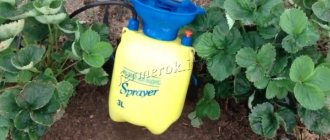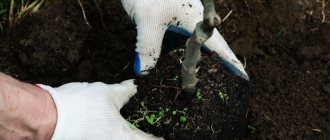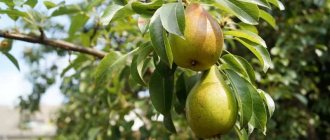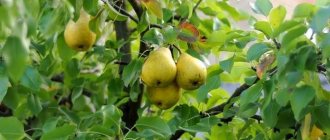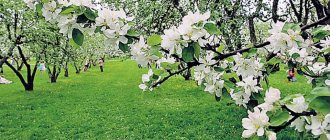Autumn fertilizing of apple and pear trees is carried out after harvesting. It is designed to compensate for nutrient deficiencies in the soil, as well as help trees prepare for winter.
It is no secret that abundant fruiting significantly weakens adult plants. But young apple and pear trees that are just taking root in a new place will also need your help to survive the frosts. As a rule, phosphorus-potassium fertilizers are used for this.
The most popular autumn fertilizers are potassium sulfate and potassium chloride, as well as superphosphate. Experienced gardeners try to avoid nitrogen-containing fertilizers during this period, because they provoke the growth of green mass, which is why the trees cannot properly prepare for winter and, as a result, freeze out.
The importance of autumn feeding of pears
Feeding pears in the fall for the winter is really very important. During fruiting, fruit trees lose a large amount of nutrients and enter the autumn period weakened.
A weak pear is more susceptible to weather conditions. As is known, in most regions of Russia they are not stable. Thaws with rain give way to severe frosts and gusty winds. And it is not always possible for a gardener to come to a plot of land in a timely manner to check whether the trees are sufficiently covered. The application of fertilizers can significantly increase the crop's resistance to the vagaries of the weather.
In autumn, the pear lays the beginnings of a harvest for the next season. During the period from the end of fruiting to the onset of cold weather, new buds are formed. You can help them by applying mineral or complex fertilizers.
Types of fertilizers
Mineral or organic compounds can be used as fertilizers for pears in the fall.
- Minerals must necessarily contain phosphorus, potassium and magnesium. Phosphorus is responsible for the formation and development of new buds. Its deficiency leads to a decrease in yield. Potassium is responsible for the timely onset of the plant's dormant period and increases its frost resistance. Magnesium helps the pear grow shoots and foliage. With its deficiency, photosynthesis processes are disrupted and tree development slows down.
- Organic fertilizers - rotted compost, humus, chicken manure - are used to feed pears in the fall with great caution. Its excess leads to the resumption or continuation of shoot growth and bud development in the autumn. Which is fraught with the death of branches, or even the entire tree, in severe frosts. However, without nitrogen compounds, a pear will not be able to lay a large number of fruits in the spring.
Interesting fact! You can determine which nutrients a pear lacks in the summer. Small and pale green leaves will indicate a lack of nitrogen. A small harvest often indicates that it is worth applying phosphorus fertilizers. Twisted foliage with yellow spots will remind you of a lack of nitrogen, and curled leaves that are light in the middle with a purple border around the edge will remind you of a lack of potassium.
To feed pears in the fall for the winter, dry fertilizers are often used. As for organic ones, they are used to mulch the soil and to protect roots from exposure to low temperatures. In dry autumn, mineral compositions are used in the form of solutions for watering the root zone or spraying shoots, that is, foliar feeding.
Types of fertilizers
Pears are fed using root technology in the fall. In the first seven years of the crop’s life, the preparations are laid out on the surface of the soil, and then dug up to the depth of a third of a spade bayonet (no more than 20 cm). The underground parts are located close, so they are loosened very carefully.
For adult specimens, a “feeding” well (30-40 cm) is made under the trunk. It is convenient to water and add nutrients through the hole. Before starting the procedures, each tree is thoroughly irrigated, after which it is allowed to begin activities.
In autumn, nitrogen-containing preparations activate the development of branches and foliage to the detriment of bark formation, which is dangerous before winter.
Organic
Natural types of fertilizers are the safest and most reliable. It is difficult to grow an environmentally friendly crop without natural fertilizing. Rotted manure remains the favorite of domestic farmers. If you use fresh feces, it is easy to burn the roots in case of accidental contact. Humus is used in combination with phosphorus-potassium additives. The frequency of applications depends on the fertility of the soil and the age of the trees:
- up to 7 years – no more than 30 kg;
- over 8 years – from 40 to 50 kg.
Bird droppings are a lighter version of manure; they can be applied to the ground in dry form. The substance is dug into the soil around the tree trunk, after which it is moistened. When wood residues, potato tops and sunflower waste are burned, ash is produced. The inconspicuous powder contains many useful microelements, so the product is mixed with humus.
Compost is a popular fertilizer that is easy to make with your own hands. The mixture consists of organic residues and manure. During the decay processes, useful substances are formed that feed the plants. The drug is poured in a thick layer (at least 10 cm) into the tree trunk circle.
Green manures are crops that enrich the soil on which they grow. They are sown in spring and autumn, mowed at the end of the season, and the soil is dug deep. Oats and rye, peas and wheat are suitable for such purposes. Additionally, the remaining roots will hide the underground parts of the pear, protecting it from frost.
Mineral components
Even the most productive varieties are difficult to grow without chemical fertilizers. A correctly calculated rate will improve metabolic processes at the cellular level and have a positive effect on the formation of buds of future fruits and the immunity of the crop. For dwarf and columnar varieties, the concentration of the solution should be one third lower than for ordinary trees. The procedures are carried out after abundant watering.
Without potassium, plants enter winter weakened. To help the garden withstand frost and sudden temperature changes, it is better to fertilize with preparations based on beneficial substances. Under each tree trunk circle, scatter 200 grams of ready-made fertilizer, cover with compost mulch on top. The element is especially important for young specimens.
Phosphorus is an important component responsible for the development and growth of trees. Deficiency negatively affects the quality of developing buds and future fruits. A characteristic sign of deficiency is early leaf fall and small blades. In the fall, adult pears need 300 grams of powder or watering with a solution. The substance is found in products such as superphosphate and bone meal.
If you do not want to mix different components, then gardening stores offer complex preparations. They contain optimal proportions of nutrients. The dosage is indicated on the packaging, so it is difficult to make a mistake. Before purchasing, be sure to check the product for the presence of nitrogen. An element needed in summer and spring is contraindicated in autumn.
When to fertilize pears in the fall
As a rule, fertilizers for mature trees are applied twice in the fall. The first time they are fed immediately after the end of fruiting with the beginning of leaf fall. The timing depends primarily on the variety. You can begin working with early or summer varieties as early as the first half of September. Next in line are mid-season and late-ripening pears. It is advisable that at least 3-4 weeks remain before the onset of stable frosty weather. Because during severe cold snaps, the fruit crop stops taking nutrients from the soil, and fertilizing will be ineffective.
Organic fertilizers, on the contrary, are applied just before the cold weather. In winter, they play the role of additional insulation, and in the spring they begin to supply pears with nitrogen compounds. It is important here not to introduce them too early, so as not to stimulate the tree to form buds in the warm autumn.
If we talk about regions, then in the middle zone and the Moscow region organic matter is introduced at the end of October, or even at the beginning of November. It is advisable to complete work in the northwestern regions and the Leningrad region 1-2 weeks earlier. Residents of the Urals and Siberia will have 1-1.5 months for both feedings in the fall. From mid-August to the end of September.
Important Warnings
If fertilizers were actively applied during spring and summer, then by autumn there is a possibility of an overdose. Excess nitrogen appears as a massive green head and branches. The crop stops strengthening the bark, which will negatively affect the future wintering. At the first frost, the pears will freeze.
Excess potassium and phosphorus leads to poor absorption of other microelements. The plant is starving, which affects the taste and shape of the fruit, as well as a modification of the color saturation of the plates. It is prohibited to independently increase the concentration of minerals in the liquid or the number of activities. During planting, young specimens receive a “nutrient cushion” on which they live during the first year, so they do not need additional procedures.
Pears do not like soil with high acidity, which can negatively affect the health of the crop. If there is no suitable place on the site, then it is necessary to reduce the aggressiveness of the environment with additives in fertilizing. For neutralization use:
- ash;
- dolomite flour;
- lime.
When alkalizing the earth, it is easy to reduce the permissible level to an acceptable level. Sawdust mixed half and half with peat is allowed as “acidifiers”. When watering, add a few lemon crystals to the water.
Autumn feeding of a pear is an important procedure that will prepare the tree for wintering. Dosed application of organic and mineral fertilizers occurs according to a certain scheme. If you follow simple rules and do not forget about care, the garden will delight you with a regular and abundant harvest.
How to feed pears in autumn
Which fertilizers to focus on in the fall depends on the purpose of fertilizing, the chemical and mechanical composition of the soil, and the age of the fruit trees.
What fertilizers to apply when planting pears in the fall
When planting a pear in the fall, gardeners try to provide it with nutrients as much as possible, because the next feeding will be only in two years. Therefore, the soil removed from the pit is mixed with 1-2 buckets of compost or humus. The optimal ratio for loamy areas is 1 part soil and 2 parts fertilizer. Mix 100-150 grams of superphosphate and 80-100 grams of potassium sulfate. It wouldn’t hurt to add 1-2 liter cans of wood ash.
Features of winter feeding
Pre-winter application of fertilizers is carried out at the root of the tree; fertilization should provide a supply of all the necessary useful components. If the seedlings are still young, substances need to be added through digging, approximately every two years from the moment of planting. If the cultivation took place before planting, in subsequent years the tree may not be flavored, but if you leave the plant without any autumn feeding at all, you can observe:
- Poor immunity.
- Fruits that taste bad.
- Shredding leaves.
It is better to prevent all these and other problems than to eliminate the consequences; mineral and organic fertilizers will bring benefits in this matter. In autumn, the pear needs to be fertilized twice, first after harvesting the fruits, and then from the moment the foliage turns yellow.
In the initial stage, it is better to use complex minerals with nitrogen; this substance will help the plant recover after harvesting. Nitrogen is added no later than September, since thanks to it the pear will actively add greenery. Incorrect or too late application of nitrogen will negatively affect the wintering of the pear.
The second stage of feeding should be organized from mid-September to November, depending on the climatic conditions of the region. The main indicator for applying fertilizer should be yellowed foliage; in the fall, the tree will benefit from peat, manure or humus. Applying organic fertilizers will concentrate the necessary components in the pear and also provide the roots with a warm shelter. A good feeding part should be at least 20 cm.
Rules for autumn feeding of pears
There are several rules for fertilizing pears in the fall that will help increase the efficiency of feeding.
- Before feeding, you need to remove the tree trunk from debris and fallen leaves.
- Dry fertilizing is carried out on moist soil, after rain or watering. The mixture is scattered at a distance of 30-60 cm from the trunk.
- It is important to correctly calculate the amount of fertilizer and the area to which it will be applied. It is believed that the diameter of the root system of an adult pear is approximately equal to the diameter of its crown.
- It is better to add dry mixtures into small holes, so they will reach the roots faster.
- Fertilizing with solutions is done in specially prepared grooves. Some gardeners also prefer foliar feeding.
It is advisable to carry out all work in dry weather. When performing them, gloves are used. If the composition is supposed to be sprayed, then use respiratory protection and goggles.
How to properly fertilize a pear, what to apply?
Fertilizing pear trees in the fall is carried out using the root method. It is better to apply fertilizers after harvesting the fruits. For the first few years, fertilizers are spread on the surface for this purpose. Then they dig up 15-20 cm. This is a little more than a third of the shovel plate. The roots are located closer to the surface, the closer the trunk. Therefore, they dig very carefully. When the pears get older, you can make a hole 30 cm deep under the tree. It is also good to use a shallow hole. Its depth is 40 cm. Fertilizers are added there.
Fertilizing in the autumn season is carried out by two main groups of fertilizers:
- organic;
- mineral.
In autumn, you should not fertilize with nitrogen fertilizers, which stimulate the processes of vegetation of shoots and trigger the growth of twigs and leaves. Spring is just right for this feeding.
Purposes of the procedure
It is necessary to feed the pear in the fall so that there is a good harvest next year. The procedure is mandatory and its necessity cannot be ignored. It is this that helps replenish those microelements that were lost during the growing season.
Autumn care ensures a safe winter. When fruiting occurs, the plant loses a lot of strength. After summer, the plant needs additional nutrition.
Mulching
Using straw, chopped weeds, and pine needles to cover open areas of land under trees is a top priority. This is not such a valuable fertilizer when compared with humus or compost. But carrying out autumn mulching is just as justified as root feeding.
Plant residues gradually decompose over autumn and winter. In the spring, you get wonderful humus with a high content of beneficial mushrooms, bacteria, and worms. The result of autumn mulching of pears is excellent humus at the beginning of the growing season.
This procedure can be performed several times a year. The main thing is to ensure that the layer is at least 10 cm. Only then is mulch an excellent home for soil representatives.
The path to a large harvest of pears lies through their roots. The tastier and healthier the fertilizers are, the more worthy the harvest will be. What fertilizing to do in the autumn season is up to everyone to decide for themselves. The choice depends on the type of soil, the age of the tree, and previous fertilization measures.
The main thing is that feeding becomes regular. Then the soil will not be depleted. And your fragrant and amazingly tasty pear harvest will bring joy to everyone and become a source of pride.
Advantages and disadvantages of autumn planting
When choosing a planting time for a pear: spring or autumn, you should take into account all the strengths of each time of year. Autumn events have a number of advantages:
- At the end of summer, the growth of green mass stops, all the forces of the plants are directed to the formation of the root system. Accordingly, seedlings planted in the fall take root faster. All nutrients will be directed to the development of the root system.
- In autumn, nurseries begin mass sales of high-quality varietal planting material. In the spring, the seedlings that are left over from the fall are usually on sale.
- In the spring, the cost of seedlings rises; in the fall, the price tags are always lower.
Seedlings planted in the fall take root faster.
But autumn planting has a significant drawback that often stops gardeners, especially beginners. Immature seedlings do not always have time to adapt and take root. If the winter is too cold and frosty, the planted young trees may simply freeze.
Typical mistakes when planting pears
When growing perennial crops, in particular fruit trees, on your plot, it is important to take into account every nuance and follow all recommended agrotechnical procedures. Any mistake can lead to irreversible consequences:
- You should not plant trees that are too mature (the seedling should be no older than 2-3 years). The older the plant, the more difficult it is for it to take root, and the pear does not like transplants. The opinion that mature trees will bear fruit faster is wrong.
- You cannot prepare the hole immediately before planting. The soil will settle, which will lead to the deepening of the root collar. And this will destroy the young plant.
- It is impossible to introduce sawdust and manure that is not completely rotted. They will continue to bicker. As a result of such processes, special substances are released that are dangerous to the root system of young trees.
- You should not overfeed pears, as excess nutrients will negatively affect crop productivity.
- Excessive mulching is also dangerous for trees. The protective layer should not cover parts of the trunk. This can lead to damage to the bark and diaper rash.
- Zoned varieties are chosen for planting so that they feel as comfortable as possible in the climatic conditions.
Pear is a heat-loving fruit plant, which, thanks to the work of breeders, is grown in regions with different climates. To get a good harvest, it is important to choose the right planting time. There are a lot of arguments in favor of the autumn season, but it is important not to make a mistake with the timing. Otherwise, the tree will not have time to take root and will simply freeze in winter.
Do you tend to stick to what time of year for planting pears: spring or autumn? Why? Share your opinions in the comments.
Feeding according to deadlines and goals
It is imperative to take into account the purpose of feeding and the growth phase of the plant. This is necessary for a good wintering and abundant fruiting. Be sure to strictly adhere to the feeding schedule.
After fruiting
Fertilizers should be applied to pear trees in the fall after fruiting together with a set of measures. Required:
- remove fallen leaves and fruits;
- loosen the soil for better air penetration;
- add at least 30 liters of water under each tree;
- prepare the tree for winter.
All this will make fertilizing after harvest more effective.
For the future harvest
In order for a young pear to bear fruit in the fall, it is fed with the substances missing in the soil. This is the only effective way to ensure next year's harvest.
Pear does not tolerate high soil acidity. Liming is required. To do this, the plant can be fed with dolomite flour. Excess alkalization can be neutralized using sawdust or peat. Finding them won't be difficult.
In preparation for winter
Fertilizing the plant before winter is required to increase resistance to frost. The planting needs superphosphate and potassium sulfate. For effective penetration of the additive, indentations must be made. This is where fertilizers are placed. For every 1 m2 add 1 tablespoon of the composition.
Immediately before the onset of frost, it is necessary to add rotted manure and peat. All nutrients will penetrate to the rhizome gradually.

